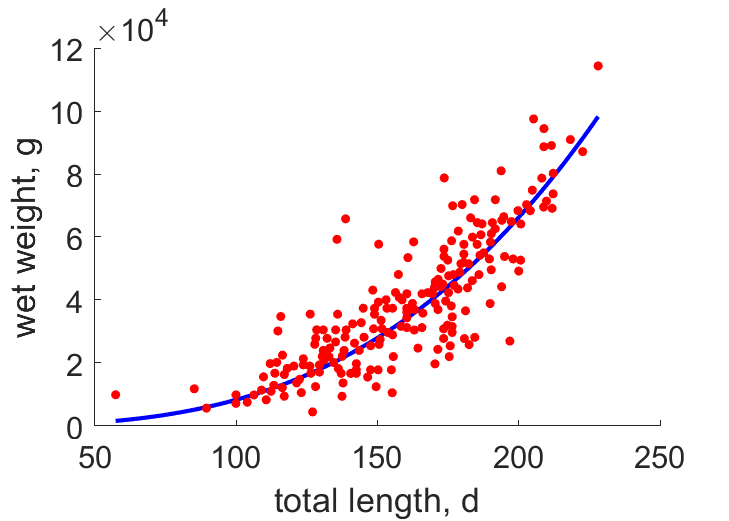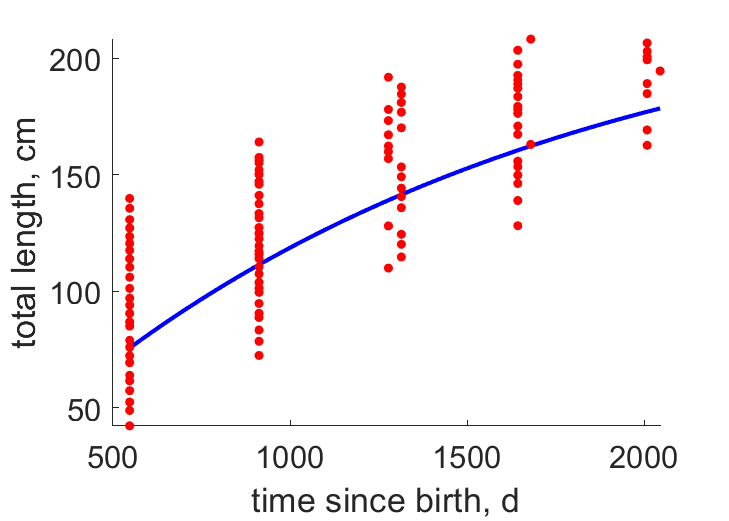Predictions & Data for this entry
| Model: std | climate: Af | migrate: | phylum: |
| COMPLETE = 2.5 | ecozone: TN | food: biCi, biCvf | class: |
| MRE = 0.095 | habitat: 0iFl, 0iFr | gender: Dg | order: |
| SMSE = 0.020 | embryo: Fnm | reprod: O | family: |
Zero-variate data
| Data | Observed | Predicted | (RE) | Unit | Description | Reference |
|---|---|---|---|---|---|---|
| ab | 9 | 8.126 | (0.09709) | d | age at birth | WWF |
| ap | 1095 | 1219 | (0.1131) | d | age at puberty | AranCast2010 |
| am | 7300 | 7300 | (6.542e-06) | d | life span | Nat_Geogr |
| Lb | 1.4 | 1.552 | (0.1089) | cm | total length at birth | FAO |
| Lp | 160 | 134.6 | (0.1589) | cm | total length at puberty | AranCast2010 |
| Li | 240 | 233.8 | (0.02565) | cm | ultimate total length | Quei2000 |
| Wwi | 1e+05 | 1.059e+05 | (0.05877) | g | ultimate wet weight | Quei2000 |
| Ri | 54.79 | 54.88 | (0.001616) | #/d | maximum reprod rate | FAO |
Uni- and bivariate data
| Data | Figure | Independent variable | Dependent variable | (RE) | Reference |
|---|---|---|---|---|---|
| LW |  | total length | wet weight | (0.2111) | Quei2000 |
| tL |  | time since birth | total length | (0.1751) | AranCast2010 |
Pseudo-data at Tref = 20°C
| Data | Generalised animal | Arapaima gigas | Unit | Description |
|---|---|---|---|---|
| v | 0.02 | 0.03239 | cm/d | energy conductance |
| kap | 0.8 | 0.9905 | - | allocation fraction to soma |
| kap_R | 0.95 | 0.95 | - | reproduction efficiency |
| p_M | 18 | 28.99 | J/d.cm^3 | vol-spec som maint |
| k_J | 0.002 | 0.002 | 1/d | maturity maint rate coefficient |
| kap_G | 0.8 | 0.8011 | - | growth efficiency |
Facts
- The arapaima has a fundamental dependence on surface air to breathe. (Ref: Wiki)
- In addition to gills, it has a modified and enlarged swim bladder, composed of lung-like tissue, which enables it to extract oxygen from the air. (Ref: Wiki)
- The arapaima male is supposed to be a mouthbrooder, like his relative, the Osteoglossum, meaning the young are protected in his mouth until they are older. (Ref: Wiki)
- Arapaima is NOT a mouthbrooder (Ref: FAO)
- W = 3.788E-05* L ^2.7045 (Ref: FAO)
Bibliography